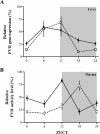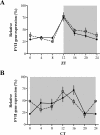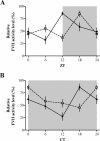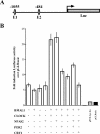Evidence for an overlapping role of CLOCK and NPAS2 transcription factors in liver circadian oscillators
- PMID: 18316400
- PMCID: PMC2293078
- DOI: 10.1128/MCB.01931-07
Evidence for an overlapping role of CLOCK and NPAS2 transcription factors in liver circadian oscillators
Abstract
The mechanisms underlying the circadian control of gene expression in peripheral tissues and influencing many biological pathways are poorly defined. Factor VII (FVII), the protease triggering blood coagulation, represents a valuable model to address this issue in liver since its plasma levels oscillate in a circadian manner and its promoter contains E-boxes, which are putative DNA-binding sites for CLOCK-BMAL1 and NPAS2-BMAL1 heterodimers and hallmarks of circadian regulation. The peaks of FVII mRNA levels in livers of wild-type mice preceded those in plasma, indicating a transcriptional regulation, and were abolished in Clock(-/-); Npas2(-/-) mice, thus demonstrating a role for CLOCK and NPAS2 circadian transcription factors. The investigation of Npas2(-/-) and Clock(Delta19/Delta19) mice, which express functionally defective heterodimers, revealed robust rhythms of FVII expression in both animal models, suggesting a redundant role for NPAS2 and CLOCK. The molecular bases of these observations were established through reporter gene assays. FVII transactivation activities of the NPAS2-BMAL1 and CLOCK-BMAL1 heterodimers were (i) comparable (a fourfold increase), (ii) dampened by the negative circadian regulators PER2 and CRY1, and (iii) abolished upon E-box mutagenesis. Our data provide the first evidence in peripheral oscillators for an overlapping role of CLOCK and NPAS2 in the regulation of circadianly controlled genes.
Figures






Similar articles
-
NPAS2: an analog of clock operative in the mammalian forebrain.Science. 2001 Jul 20;293(5529):506-9. doi: 10.1126/science.1060699. Epub 2001 Jul 5. Science. 2001. PMID: 11441147
-
Interaction of circadian clock proteins PER2 and CRY with BMAL1 and CLOCK.BMC Mol Biol. 2008 Apr 22;9:41. doi: 10.1186/1471-2199-9-41. BMC Mol Biol. 2008. PMID: 18430226 Free PMC article.
-
Post-translational regulation of circadian transcriptional CLOCK(NPAS2)/BMAL1 complex by CRYPTOCHROMES.Cell Cycle. 2006 Apr;5(8):890-5. doi: 10.4161/cc.5.8.2684. Epub 2006 Apr 17. Cell Cycle. 2006. PMID: 16628007
-
[Synchronization and genetic redundancy in circadian clocks].Med Sci (Paris). 2008 Mar;24(3):270-6. doi: 10.1051/medsci/2008243270. Med Sci (Paris). 2008. PMID: 18334175 Review. French.
-
Genetics and neurobiology of circadian clocks in mammals.Cold Spring Harb Symp Quant Biol. 2007;72:251-259. doi: 10.1101/sqb.2007.72.052. Cold Spring Harb Symp Quant Biol. 2007. PMID: 18419282 Free PMC article. Review.
Cited by
-
Role of the Circadian Gas-Responsive Hemeprotein NPAS2 in Physiology and Pathology.Biology (Basel). 2023 Oct 22;12(10):1354. doi: 10.3390/biology12101354. Biology (Basel). 2023. PMID: 37887064 Free PMC article. Review.
-
Introduction to the Clock System.Adv Exp Med Biol. 2021;1344:3-20. doi: 10.1007/978-3-030-81147-1_1. Adv Exp Med Biol. 2021. PMID: 34773223
-
Disrupting the circadian clock: gene-specific effects on aging, cancer, and other phenotypes.Aging (Albany NY). 2011 May;3(5):479-93. doi: 10.18632/aging.100323. Aging (Albany NY). 2011. PMID: 21566258 Free PMC article. Review.
-
In vitro assessment of Neuronal PAS domain 2 mitigating compounds for scarless wound healing.Front Med (Lausanne). 2023 Feb 1;9:1014763. doi: 10.3389/fmed.2022.1014763. eCollection 2022. Front Med (Lausanne). 2023. PMID: 36816724 Free PMC article.
-
Therapeutic downregulation of neuronal PAS domain 2 (Npas2) promotes surgical skin wound healing.Elife. 2022 Jan 18;11:e71074. doi: 10.7554/eLife.71074. Elife. 2022. PMID: 35040776 Free PMC article.
References
-
- Akashi, M., and T. Takumi. 2005. The orphan nuclear receptor RORalpha regulates circadian transcription of the mammalian core-clock Bmal1. Nat. Struct. Mol. Biol. 12441-448. - PubMed
-
- Campo, G., M. Valgimigli, P. Ferraresi, P. Malagutti, M. Baroni, C. Arcozzi, D. Gemmati, G. Percoco, G. Parrinello, R. Ferrari, and F. Bernardi. 2006. Tissue factor and coagulation factor VII levels during acute myocardial infarction: association with genotype and adverse events. Arterioscler. Thromb. Vasc. Biol. 262800-2806. - PubMed
-
- Cheng, M. Y., C. M. Bullock, C. Li, A. G. Lee, J. C. Bermak, J. Belluzzi, D. R. Weaver, F. M. Leslie, and Q. Y. Zhou. 2002. Prokineticin 2 transmits the behavioural circadian rhythm of the suprachiasmatic nucleus. Nature 417405-410. - PubMed
Publication types
MeSH terms
Substances
Grants and funding
LinkOut - more resources
Full Text Sources
Molecular Biology Databases
